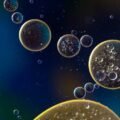SpaceX just launched a fresh set of supplies to the International Space Station (ISS), including a batch of custom-made human muscle cells. Once aboard the ISS, the unusual package and the researchers behind its contents hope the accelerated effects of muscle loss experienced by astronauts living in zero gravity will help them solve some of the mysteries behind age-related muscle decay, as well as other muscle-wasting medical conditions.
BACKGROUND: ASTRONAUTS LOSE MUSCLE JUST LIKE SENIORS
On Earth, humans lose muscle mass as they age. Although some of the mechanisms are well known, exactly how to reverse those effects is still not totally understood. The same can be said for some medical conditions that also cause muscle loss. Fortunately for researchers who specialize in this area, astronauts who spend any extended time in the zero-gravity environment of space experience a similar, if not significantly more rapid muscle decay.
This similarity has led researchers from the University of Liverpool in England to design a batch of muscle cells for specific experiments, which were part of the package just launched to the ISS.
ANAYSIS: ZERO G MAY HOLD THE MUSCLE LOSS KEY
“Identification of the underlying mechanisms responsible for this loss of muscle mass and strength with age has been the subject of our research for a number of years,” explained Professor Anne McArdle from the University’s Institute of Life Course and Medical Sciences, in a press release announcing the unusual launch. “Astronauts in microgravity lose their muscle mass and strength at an accelerated rate compared with older people on earth, providing a unique model to rapidly determine the mechanisms underlying muscle loss not only in astronauts, but with relevance to older people on earth.”
Part of the university’s MicroAge project, the 24 individual cells are about the size of a grain of rice and will be subjected to a range of tests designed to unlock some of the secrets behind muscle loss. This will primarily involve subjecting the cells to electrical impulses and measuring their reactions.
“Ageing is one of the greatest challenges of the 21st century and we will learn a great deal about how muscle responds to microgravity and ageing from the data we obtain from this study,” explained project team member Professor Malcolm Jackson in a release from the U.K. government.
“The team has had to work extremely hard over the last three years to overcome the many challenges of sending our science into space,” added Jackson. “For example, the electronic equipment necessary to undertake these studies usually fills a large desk but we have managed to shrink this to the size of a pack of cards.”
OUTLOOK: RESEARCH MAY HOLD KEY TO OTHER CONDITIONS AS WELL
All told, the 24 cell samples will spend only a short time on the ISS, with a return trip to Earth scheduled for January of 2022. But depending on the results of the experiments, that may be all of the time needed to unlock wide ranging benefits to a large portion of folks dealing with muscle attrition, whether caused by age or other medical conditions.
“The research of our scientist astronauts like Tim Peake on muscle loss in the microgravity of space is helping identify potential cures for musculoskeletal disease, which causes agony to millions and costs the NHS billions,” explained the U.K Science Minister George Freeman in a prepared statement. “By harnessing the unique environment of the International Space Station our pioneering scientists could help us all live healthier, stronger lives.”
Follow and connect with author Christopher Plain on Twitter: @plain_fiction
